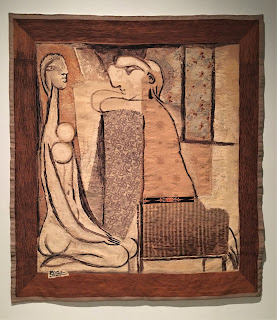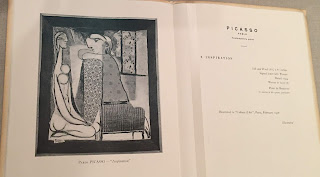In 1930s Paris Marie Cuttoli (1879-1973) convinced the most celebrated artists of her time - including Picasso, Miro, Leger, and Man Ray - to create designs for the historic tapestry workshops of Aubusson, France. Cuttoli's venture gave new life to an artisan tradition and brought modernism to new audiences. In Barnes Foundation exhibition it is possible to see designs for textiles, which they call cartoons (some of them later were sold as paintings), and tapestries made from those designs. Why the name cartoon? Because those designs were made as large as the tapestry will be woven and put underneath, so weaver could follow the pattern.
The first object is this fabulous evening dress, embroidery for which was designed by Natalia Goncharova, Russian avant-garde painter whose costumes for The Ballets Russe Cuttoli admired. In 1922 Marie Cuttoli opened her fashion house and boutique Myrbor in Paris, in the same neighborhood as Chanel and Lanvin. In 1926 Cuttoli renovated her boutique and rebranded it as Galerie Myrbor, presenting modern art alonside fashion and rugs.
The red silk jacket's embroidery design is also attributed to Natalia Goncharova.
Braque incorporated sand in his oil painting. In the tapestry that effect is done by light absorbing wool and light reflecting silk.
Cuttoli's venture related closely to mural decoration, a topic that fascinated artists in 1930s. Tapestries had many of the same qualities as murals with the added benefit of portability. Designing for Cuttoli pushed artists to take their work in new directions, experimenting with scale and process alike. Man Ray used a rayograph in his design, bringing an innovative photomechanical process into an artisan tradition. The architect Le Corbusier, who was flattered to join a group that included Picasso, Braque, and Leger, worked up sketches for a cartoon titled Marie Cuttoli, an experience that informed his later conception of tapestry as mural for the modern era.
The back side of the tapestry shows that the weaver got colors very well but over the years the tapestry has faded.

































